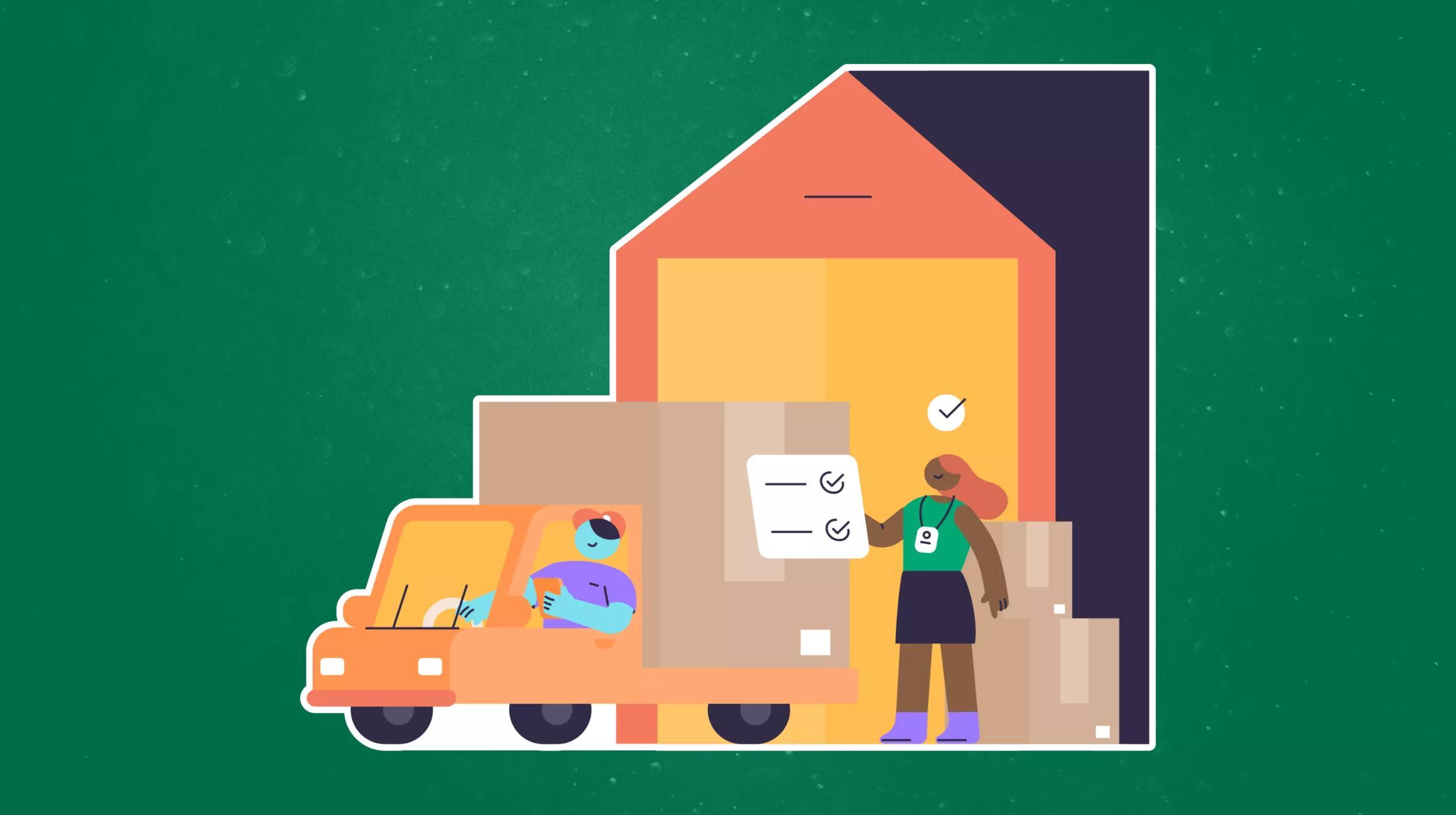As a web developer, there will inevitably come a time where you’ll need to migrate a WordPress site from one host to another. Maybe it was a test project you were working on, or you want to change the structure of the website, optimize it, or you might just want to move away from your current host to move to another one.

Go from idea to online in minutes with GoDaddy Airo™
Get started now.
Migrating can be a daunting task; one you don’t always want to take. And when you do, you want to make sure to tread lightly to make sure you avoid any data loss and long downtimes. Like any project, understanding what to do before jumping in is key. Here’s what you need to know:
An important note before we jump in: If you’re migrating your sites to GoDaddy Managed Hosting for WordPress, you can migrate your current WordPress sites in a few steps!
How to know when it’s time to switch WordPress hosts
The first step when switching WordPress hosts is to recognize the signs that it’s the right time to switch. Moving hosts can be a tough task, so it is important to be sure you’re making the right decision for your business, or for your clients.
These are the main reasons you might want to investigate switching to a new WordPress host:
1. Your site is often down when you aren’t expecting.
Unexpected downtime is bad for business, and frequent drops in traffic can also affect your search rankings. If your site is down multiple times each month, and the host is to blame, it’s a clear indication you need to switch to a new host.
2. Your current host is too slow.
Having a fast and responsive site is an important factor when optimizing your site for higher search rankings and providing a better user experience. If your site continues to load slowly even after disabling unnecessary WordPress plugins and performing optimizations, a new host with better infrastructure might be the right solution.
3. Your current host’s customer support is poor.
When your site is down, the last thing you want is to hear that customer support can’t help you. If your host’s support team is slow to respond, difficult to reach, or they simply don’t know how to help, it’s time to look for a new one.
4. Your current host is missing key features.
Say you’re looking to add ecommerce functionality to your WordPress site, but your host doesn’t support WooCommerce. Rather than trying to set up and manage the software yourself, it’s easier to find a host that either manages the functionality for you, or at least supports it.
5. Your current host doesn’t back up your site automatically.
Having frequent backups of your site is critical—without one, recovering your site can be slow and painful, if not impossible. If your current host doesn’t provide frequent backups of your site for you, it’s prudent to look for a new one.
6. You have to install WordPress updates yourself.
Most managed WordPress providers should automatically install WordPress core updates and security patches for you. If your current host makes you manage this on your own, you can save time and reduce risk by switching to a managed WordPress host instead.
It’s important to note that every provider will have some things you’re happy with, and other things you don’t like. While you might be able to live with one or even two of these red flags, if more than two of the above items are affecting your sites, or if one or more problems keep coming up over and over, that’s a clear sign it’s time to find a new web hosting provider.
What to do before you migrate a website
As with any web project, success starts with preparations in advance. From the size of your database and files to the number of plugins, backups, and media, everything factors into how slow or fast the migration can be, and how you can plan for a more seamless migration. So, what should you do before you migrate a website? Before you roll up your sleeves and get started, follow these steps:
- Take inventory of all the content so you have a checklist of everything that must migrate from point A to point B. If you identify content that does not need to migrate, such as unused plugins or themes, delete them. You want to transfer only the content that is current.
- Note your current themes. Review your theme files and note any additions you made to code.
- Take inventory of your network resources and configurations including IP information, domain names, firewall access control lists, internal and external DNS entries.
- Review your JavaScript and PHP frameworks and versions for your site so you have a smooth transition.
- Contact the provider who issued your SSL certificate to understand the terms and conditions related to migrating your site.
- Understand the size of your website. Some may be too big (over 1GB) to automatically migrate. Rather than guessing based on size of tables, number of posts or inventory of orders, export a compressed SQL file to understand the actual size of your database. For large databases, plan on migrating using SSH commands.
Are you migrating a large ecommerce site? Take some extra steps to make sure your product data, customer data and order histories transfer. Organize all your user, product and catalog data and highlight what should be migrated.
Finally, as part of your preparation, enable a maintenance page that will provide a user-friendly message to users with alternative links to visit when the site is undergoing migration.
Step 1: Back up your website files.
Backups are important because if you run into any problems during migration — like corrupted or missing files — you’ll be able to restore that data from your backup.
Start by retrieving your website files from the original host. Most hosts also allow you to be able to compress all files into one zip file, making it easy to download the data. You can either use the backend control panel like cPanel or use file transfer protocol (FTP) to download them to your local computer.
Step 2: Export the database.
Once the transfer is complete, you can move on to copying the database. The database is the most important piece of your WordPress site — it’s the brain that holds all your pages and posts.
Similar to the file backup, you will start by making a copy of the database. Most hosts offer access to a database through phpMyAdmin. To copy the database:
- Log in to your host control panel and access phpMyAdmin.
- Select your website’s database from the left column and then click Export from the top menu bar. The export method should default to Quick, which is acceptable for these purposes. You’ll also want to make sure that the format is SQL. This will ensure that your backup is universally acceptable for MySQL.
- Click Go, and you’ll be prompted to download the .sql file. Move this file into the same folder as your website data and files to keep track of it while you complete the migration.
When migrating your client’s WordPress site, be aware of database size. Database export or import might fail due to database size. Some big databases can only be imported via SSH. You should check your customers’ database size, which one is the biggest table, how many posts there are, and how many orders for WooCommerce installations. The answers to these questions can determine if your client’s site is a good fit for the hosting which you are trying to migrate it to.
How to choose a new WordPress host
When you’re choosing a new managed WordPress host, it’s critical to make sure you pick the right balance of features and service, fit for your website. After all, the last thing you want to do is be switching hosts again only a few months down the road!
There are a lot of benefits when choosing managed Hosting for WordPress over regular hosting:
- Most managed WordPress providers will offer to migrate your WordPress sites for you — GoDaddy included.
- Many providers will automatically install useful and commonly used plugins for you, such as WooCommerce or Yoast SEO.
- A lot of managed Hosting for WordPress plans include a free staging site, making it easier to test out changes to your sites without affecting the live site.
- WordPress core updates, security patches, and even some plugin updates are managed automatically for you.
- Managed WordPress hosts will regularly back up your site and make it easy to quickly roll back your site to a prior backup if needed.
- Having a dedicated WordPress customer support team ensures you can always get a hold of someone who can fix your problems.
Of course, we’d always recommend choosing GoDaddy Managed WordPress for your hosting needs—with simple installation and migration, pre-loaded themes, automatic updates, and award-winning customer support, GoDaddy makes it easy to get your WordPress site up and running.
Now that you’ve chosen your host, it’s finally time to get the migration started!
Migrating your site
If your preferred host does not have a one click migration method, like GoDaddy’s Managed WordPress, or if you’d just like to have a bit more control, you can either choose to use a plugin to perform the migration, or upload the files and the database yourselves and edit the right configuration files. If choosing between the two, we suggest using a plugin since that helps not only automate several steps but also avoid making mistakes in between. We’ll go through both options here.
Migrating a WordPress site using plugins
One of the easiest ways to do a semi-automated migration is with the help of a plugin. There’s lots of great options out there, but two of the more reliable and tested ones are Duplicator or All-in-One WP Migration tool. For either, you simply set up the plugin and use their Export and Import functions.We’ll focus in on the Duplicator plugin and the steps involved to migrate your website using Duplicator:
1. Prepare your old WordPress site for migration
The first thing to do is to download the plugin. Navigate to Plugins > Add New and type “Duplicator” into the search bar. Once you find the right plugin (as in the screenshot), click Install Now, and then activate the plugin once it’s installed.
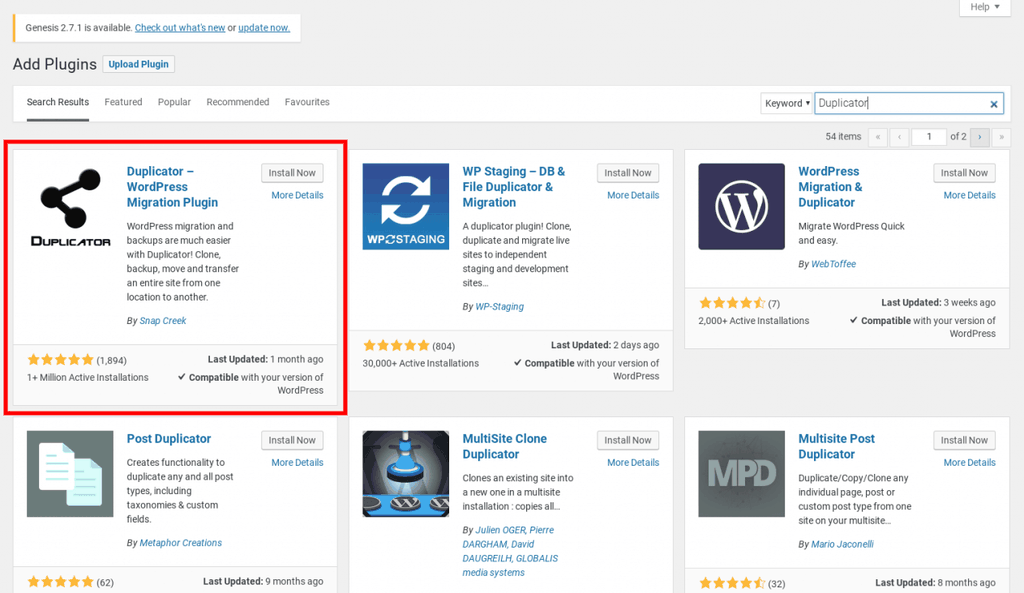
2. Package up your old WordPress database (and site)
Now that you’ve installed Duplicator, you can use it to package up your site for moving it to a new host.
To get started, from your side menu, go to Duplicator > Packages, then click Create New in the top right-hand corner.
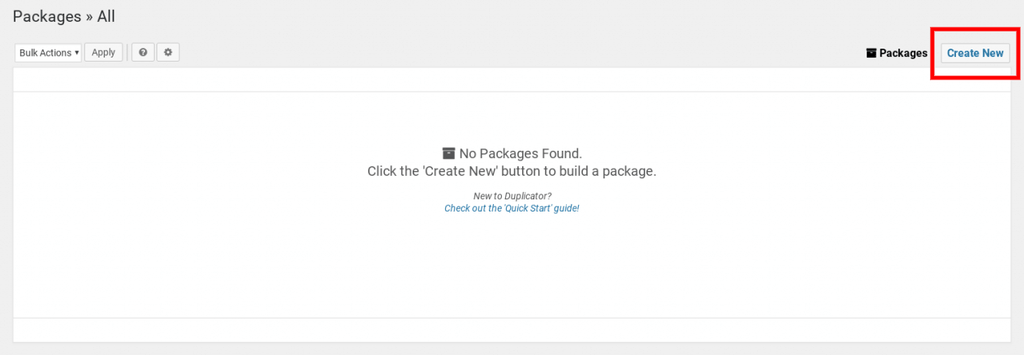
On the next screen, you’ll see a few options for creating the package, including where you want to store the archive and the installer, and components that should be archived, including plugins, themes, and more. Note that while you do get some additional options as part of the Duplicator Pro package, such as cloud storage for backups and a branded installer, if you don’t want to upgrade you don’t need to, as most sites can make do with the default settings.

One important thing to note is the size of your website. As of the writing of this article, unless you have Duplicator Pro, larger websites need to be migrated using their “Two-Step Install” method or the “Database Only” method. This is mainly for Duplicator Lite, where your file may be bigger than what the Lite version can support. In that case you’ll have to either follow the “Two-Step Install” method or get Duplicator Pro. The “Two-Step Install” method just lets you archive the database only in this step, and then relies on you to transfer your website files yourself (easily done by compressing them, downloading the compressed file, and uncompressing them on the new host).
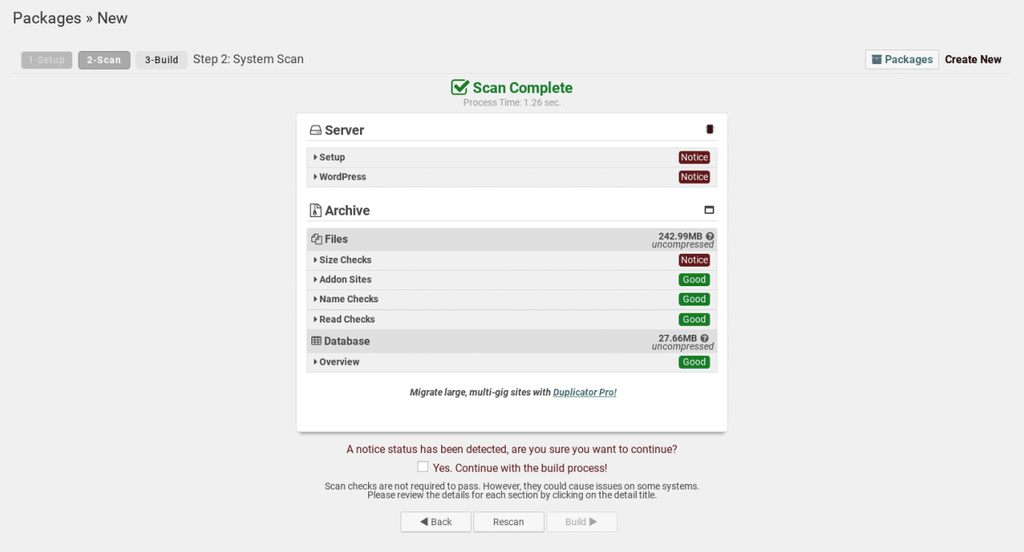
Once you click Next, Duplicator will scan your environment to do a quick check, revealing a page with the results of the scan. The scan should only take a few seconds. At this point, the plugin will warn you if you have any issues that might affect the migration of your site, such as an unsupported server setup or any enormous files.
If any errors come up, you can check the FAQ page for the plugin for more information on how to resolve the issues before running the scan again.
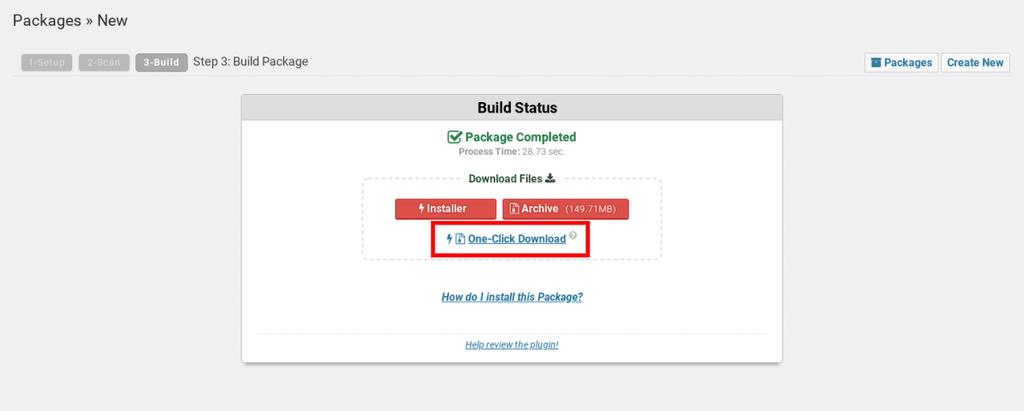
If everything looks good, click Build to build the package! Depending on the size of your site, it may take a few minutes for the build process to complete. Once it is complete, you’ll see a page saying Package Build Completed and you’ll be able to download both the Archive and the Installer files. Simply click Download Both Files to download both to your computer.
3. Create the MySQL database and user on the new host
This step assumes you’re moving to a vanilla web host without a managed WordPress offering. If your provider offers managed Hosting for WordPress, it’s much more convenient to have your provider take care of the migration for you.
While the Duplicator installer can install WordPress for you on the new host, you still need to manually create the database and set up a new user, since the plugin can’t do that on its own.
If your new host offers cPanel access, you can quickly set up the new database and user from within cPanel. (Here are instructions for how you can set up the database on GoDaddy’s cPanel hosting.)
If your new host doesn’t offer cPanel access, you should be able to find instructions for creating the database in their support documentation.
When you create the database, make sure to give it a memorable name, since you’ll need to enter it into the Duplicator plugin later. It can help to prefix the database name with “wp_” so you remember it’s a WordPress database, especially if you have multiple databases on the same server.
Make sure you also record the new username and password somewhere secure, as we’ll also need those when we set up the new site within the Duplicator plugin.
Finally, make sure the new database user has all privileges assigned for the database you’ll be using.
OK, time for the next step—installing the site on the new host!
4. Import the Duplicator files to your new host.
Next, you’ll need to upload both the installer and archive files you downloaded from Duplicator earlier to the root folder on your new host. Make sure the root folder is completely empty, then upload the files using the File Manager in cPanel or using FTP.
5. Perform the migration.
Once the files are uploaded, you’ll need to access the installer.php file in your browser to start the installation process. There’s one caveat, though: your domain is still pointing to the site on the old host, so you’ll need to access the new site directly via its IP address. If your site is on a shared hosting provider, you’ll also need to include your username in the address as well.
In cPanel, find the IP address of the new server, along with your username. In your browser, enter the IP address of the server, followed by “~username/installer.php”. Be sure to replace username with your username. Both the IP Address and the username are marked in red in the screenshot below.
The address bar should look something like this: http://12.34.56.78/~myusername/installer.php
When you make it to the installer, the first page will prompt you to go over the installation overview (in most cases you’ll want to just keep those settings), and also input the database details you had from earlier when you created a new database and user. Input those details here in the Database Connection portion.
Click Validate and the installer will go through a couple of validation steps to make sure it can connect to the database properly. Once it does, it’ll give green lights or notices. If there are any issues, go back to the FAQ page for the plugin to check before you proceed.
Click Next and you’ll see the Install Confirmation. If everything looks good, click OK!
If everything has gone according to plan, the final screen should show you all green and good, with a database report and a blue button to login to the WordPress admin portal for the new site.
Congratulations! You’ve completed the migration!
6. Login to the site and ensure everything is working properly.
At this point, it’s a good idea to double-check that all your files have been migrated properly to the new host before deleting anything from the old host or canceling your account.
First login using the same Admin login as your old website, and make sure everything is working properly, including the public facing site. Alongside that, using the File Manager in cPanel or your FTP software, ensure all the files on the new host match the files on the old host. If you spot a few extra files on the new host from the installation process, they can be safely ignored. If you happen to spot anything that’s missing, simply transfer the file over manually using cPanel.
7. Update your DNS records to point to the new host.
Once you’ve checked all your files have transferred properly, you’ll need to update your domain name to point at the new host. The exact method of updating your DNS records varies by DNS provider, so it’s best to look up specific instructions in your provider’s support documentation.
On the new host, follow the instructions to add your domain to the new account. After linking the domain to your account, you should be provided with two or more name server addresses to point your domain name to. Add those name servers to your existing DNS host, making sure to completely clear out the old addresses.
Remember, any changes to your DNS records could take up to 48 hours to propagate throughout the world. If you just can’t wait to get started on your new site, be sure you’re able to access the new site on your existing domain before making changes!
8. Test everything again thoroughly.
Once the migration is complete, it’s time to make sure everything’s working as expected on the new host.
First, it’s helpful to verify that the DNS changes have updated, and you’re definitely updating the new site instead of the old site. One way to do this is to upload a file using WordPress’s Media Manager, then try to find the file you uploaded using the File Manager in cPanel on the new site. Once the file shows up you can start making changes, confident that you’re updating the new site.
Once the new WordPress site is up and running, it’s important to make sure your permalinks to your posts and pages are updated. In WordPress, go to Settings > Permalinks, and click Save (you don’t need to change anything else on this page). This makes sure all the permalinks are refreshed to match the new host, since they sometimes get messed up during a migration.
After refreshing the permalinks, navigate around your site, clicking on every page, post, and link you can. Look for missing images, broken links, and other signs that things might be broken. If you find any problems, be sure to fix them in WordPress.
Also, be sure to delete the installer and archive files from the Duplicator plugin, since they can pose a security risk. The Duplicator plugin makes this fairly straightforward—simply click “Auto delete installer files after login to secure site” in the final step of the installer to delete those files. You can also delete the files manually using cPanel.
Finally, be sure to cancel your account with your old hosting provider, so you don’t get charged twice! Give yourself a pat on the back—you’re done!
Migrating a WordPress site without plugins
You could also migrate your entire site without using any plugins. Follow these steps:
- Step 1: To upload your website files, log in to the destination account using FileZilla and browse to the web root of the destination hosting account. If you are using cPanel, this is typically the public_html/ folder. Then, drag your website files from your local computer to the new host’s web root. Depending on the size of your uploads folder and plugins, this process may take some time.
- Step 2: Create a database in the new destination by logging in to the destination account’s control panel. If you are using cPanel, you are looking for the option MySQL® Databases. Create a new database and name it appropriately for your site.
Once you’ve created the database, create a new database user and then add the new user to the new database with ALL PRIVILEGES. Make sure to write down the database name, username, and password — you’ll need them for later.
- Step 3: Import the database by logging in to phpMyAdmin on the destination account and click on the name of the new database that you just created. Then on the top bar click Import. Click the browse button and select your .sql file that you made earlier. Click Go, and the database will begin importing. Depending on the size of your site, this process might take some time to complete.
- Step 4: Next, fix the wp-config.php file to meld the files and database. You can edit this file in FileZilla by right-clicking on it and selecting Edit (cPanel also provides a file manager where you can make edits to this file). What you’re looking for are the following settings in this file:
define('DB_NAME', 'new_db'); define('DB_USER', 'new_db_username'); define('DB_PASSWORD', 'new_db_password'); define('DB_HOST', 'localhost');
Take the database information that you wrote down earlier and replace the old database information in these lines of code with the new credentials.
Navigate to the public site using the IP address method above and you should be able to see your site up and online!
What to do after migrating your website
So, what should you do after migrating a website?
At this point, your website should be in working order if the domain has remained the same during the move and DNS is already set up. But if you need to do a domain change, the site URL and home URL will need to be changed to reflect the new domain.
You can do this temporarily by adding the following lines to your wp-config.php file with your domain replacing the text “example.com”:
define(‘WP_HOME’,’https://example.com’);
define(‘WP_SITEURL’,’https://example.com’);
If you don’t want to add temporary domains, you can use a host file to preview your client’s website on a new hosting before going live with DNS change. You can do this by adding entries to the host's file on your local computer.
You should also do a general “find and replace” to find all instances of the old URL. Often, these URLs end up in many more places than just the configuration. Plugins such as the Better Search Replace can be helpful in speeding up this process.
If the domain will remain the same after the migration, you’ll only need to change the A record for your domain to point to the IP address of your new hosting account. This process varies between registrars, so it’s best to discover how to do this part with whomever you purchased your domain from.
Additionally, some WordPress themes also require additional steps after you complete the previously mentioned steps. For example, if you’re using the Avada theme, you will need to clear the Avada Fusion Builder cache after migration.
Post-migration checklist
At this point in your migration, do some quality control and double-check that the migration went well. Follow these steps:
Step 1: Make sure your permalinks to your posts and pages are updated. In WordPress, go to Settings > Permalinks, and click Save (you don’t need to change anything else on this page). This makes sure all the permalinks are refreshed to match the new host since they sometimes get messed up during a migration.
Step 2: Now, check to make sure pages, posts and links are showing up and working properly. Check for missing images, broken links, and other signs that things might be broken. If you find any problems, be sure to fix them in WordPress. Some common areas to troubleshoot include:
- Contact form not sending emails after migration
- Modify control files accordingly in website builder
- PHP version differences on website source and hosting destination
- Check for remnants from previous hosts in WordPress files (for example, WP Engine and BlueHost)
Step 3: Delete the installer and archive files from the tool you used, since they can pose a security risk. Keep the local backup copy of your files and the database export, along with the original wp-config.php file in case you need to reverse the migration.
Step 4: Cancel your account with your old hosting provider so you don’t get charged twice.
Step 5: Make sure your website has SSL, CDN and Firewall configuration.
Pro tip: Update your IP in your Firewall settings after migrating to a new host.
Looking for a super easy way to migrate your WordPress site? Learn about GoDaddy’s 1-Click WordPress Migration, Abstract Hub’ s website design and management services, or check out the Hub by GoDaddy Pro for streamlined migration and backups for WordPress sites plus priority support whenever you need it.
Disclaimer: This content is for informational purposes only and should not be construed as legal or financial advice. Always consult an attorney or financial advisor regarding your specific legal or financial situation.
